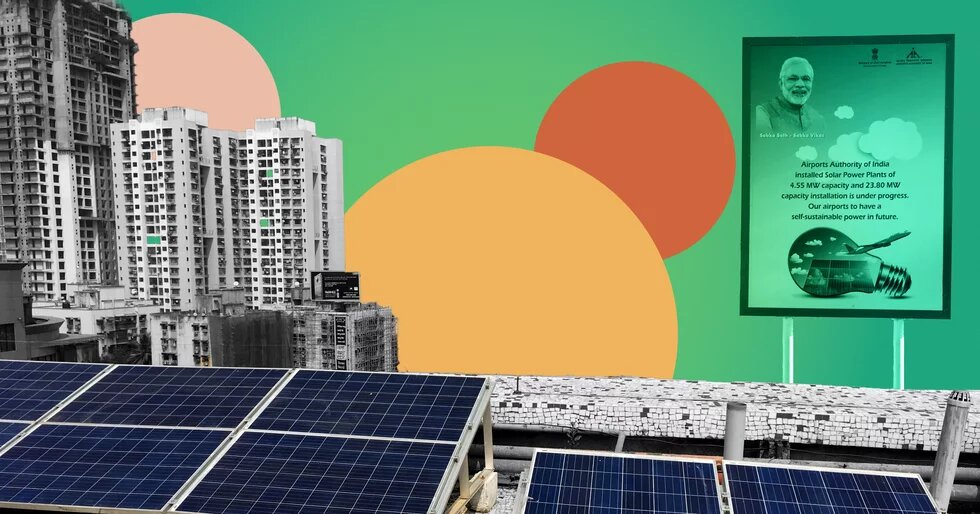India's energy transition has become a prominent issue in both the BJP and Congress manifesto. Although the nation's clean energy future has been firmly set in motion, financial and policy challenges lie ahead for the future government.

In February 2024, a month before the announcement of the 2024 seven-phase general elections, Prime Minister Narendra Modi launched ‘PM Surya Ghar: Muft Bijli Yojana’ (Free Electricity Scheme) aimed at benefiting about one crore (10 million) households. Under the scheme, households who install rooftop solar are set to get 300 units of electricity free every month. On March 7 — less than 10 days before the election dates were announced — the government made another announcement: it will continue with the subsidy of Rs 300 per gas cylinder for another year. This would benefit around 10 crore families (100 million).
The schemes are likely to cost the exchequer a whopping Rs 87,000 crore (USD 10.4 billion).
However, this figure is not even the tip of the iceberg. It is estimated that India needs about USD 10 trillion by 2070 for its energy transition. But finance is not the sole concern. Factors like flip flop of policies, lack of a robust domestic renewable energy industry, and social and environmental concerns due to rapid renewable energy growth are the major challenges. However, this has not discouraged the key political players from focusing on programmes related to energy transition.
A quick analysis of the manifestos launched by the two major political parties of the Bharatiya Janata Party (BJP) and the Indian National Congress (INC) ahead of the 2024 elections shows the importance of the issue of energy.
In its manifesto, the governing BJP has dedicated a full page to energy transition. Titled ‘Energy Security’, the page talks about major energy-related initiatives, including cutting the reliance on the import of fossil fuels to ensure energy independence by 2047; expanding the renewable energy footprint including massive support for mega solar and wind parks; expanding rooftop solar through the PM Surya Ghar: Muft Bijli Yojana scheme; green hydrogen; electric mobility and battery storage; expanding nuclear energy; establishing a smart grid; and developing India as a manufacturing hub in renewable energy.
On the other hand, the Congress has emphasised on mobilising capital for the energy transition with a focus on solar pumps, incentivising panchayats (village local bodies) to establish and maintain solar grids, and establishing a green transition fund for investments focused on renewable power in its manifesto. It also stresses on increasing the use of gas cylinders to promote clean cooking.
To Karthik Ganesan, Fellow and Director (Research Coordination) at the Delhi-based think tank Council on Energy, Environment and Water (CEEW), this is a clear signal to voters that the government has chosen to make clean energy more affordable to the masses and that the people should elect this government back to power so that consumer prices remain on a decreasing trend.
Alok Kumar, who was the secretary of the Ministry of Power between February 2021-June 2023, observes that energy transition may not be a central agenda in India’s politics or election campaigns but its critical components such as decentralised renewable energy, solar rooftop and electric transport systems are important to the electoral process.
“Energy transition may not become a mainstream agenda in itself but its components will always find a place in one form or another,” says Kumar, who is now the Director at Delhi office/chapter of The Lantau Group, a global consultancy firm working on energy transition.
With the Indian electorate slowly embracing the idea of energy and good quality of life going hand in hand, the push for the clean energy transition is here to stay. One crucial thing that the policymakers may need to remember is that people may need financial support in this transition otherwise the price-sensitive electorate can adversely push back.
A clear clean energy transition path awaits India
Energy is a vital part of national and state programmes. Schemes related to rooftop solar, decentralised renewable power, smart grids, waste-to-energy plants, solar water pumps, electric mobility programmes, and clean cooking fuel are among the many energy schemes that the central and state governments are using to woo the people across the rural and urban landscape.
Over the last 10 years, the BJP government has taken many steps to push for clean energy. If voted back to power, it vows to continue.
The Indian government has set itself the target to achieve at least 500 GW of non-fossil fuel installed capacity, which includes 280 GW of solar power and 140 GW of wind power projects, by 2030. This means that India will need an average annual addition of installed capacity of about 40-50 GW of renewable power for the next few years. No matter which party is voted to power in the 2024 general elections, there will be a clear clean energy path to follow.
Explaining how the successive national governments drove India’s energy transition, Sandeep Pai, Director, Research & Strategy at think tank Swaniti Global, says the United Progressive Alliance (UPA) government started the energy transition with the humble target of achieving 20GW of solar by 2022 under the National Solar Mission which was launched in January 2010.
“But when the (National Democratic Alliance) NDA government came to power, they raised the ambition. India now has ambitious 2030 RE targets. In the last 10 years, the NDA government accelerated the renewable energy redeployment, clean cooking transition and energy efficiency measures. Can they do more? The answer is yes.”
But there were many policy changes and a lot of back and forth which Pai says is not a good sign for investors and industries. He argues that despite the acceleration in renewable energy installation, frequent policy changes have adversely impacted the growth. “Thus, one thing that is required is policy stabilisation,” he says.
“It is also one of the reasons that while the renewable energy acceleration has happened it has not been able to keep pace with the government’s own targets. Thus, one thing that is required is policy stabilisation. However, that is not a feature of only this government but has been there historically,” he argues.
Though there are arguments that frequent policy changes impacted the growth, experts stresses that India has still made huge strides on the energy transition path.
For instance, according to former union power secretary Alok Kumar, working on promoting international collaboration on energy and climate with the International Solar Alliance and the Global Biofuel Alliance is another example of the country’s commitment to achieving its clean energy goals.
“The national policies on amendment to energy laws, renewable purchase obligations, carbon trading scheme, PLI (Production Linked Incentives) schemes to promote renewable energy, green hydrogen mission, green energy corridors, rooftop solar programmes is a testament to the massive focus on India’s energy transition,” he says.
Kumar notes that India is on track to achieve its 2030 climate goals though it may slip by a year or two on achieving the installation capacity of 500 GW from non-fossil fuel resources.
What are the challenges?
In discussions around energy transition, what is undeniable is that there is no looking back for India even though there are challenges that need to be taken care of. To name a few, India needs an unhindered flow of investments into renewables, a robust domestic renewable manufacturing industry and policies that address the social and environmental concerns arising due to renewable energy growth. Experts maintain India’s energy goals are crystal clear and the energy transition ball has already started rolling irrespective of who is in government.
Aarti Khosla, who heads the New Delhi-based research consultancy firm Climate Trends, says, “If one looks at geopolitics, India has a good story to tell at the moment compared to other regions such as South East Asia, where investments for clean energy are decreasing, or Europe, which is struggling to meet their clean energy goals despite big targets.”
“With policy and political stability, investors and diplomacy efforts alike should find investing in India less risky. More private investments should also contribute to the consistent rise of renewables,” says Khosla.
Experts note that it is no secret that financial constraints are a challenge for India in pursuing its energy transition goals till 2030 and beyond and that is why the country needs a comprehensive assessment of least-cost pathways to achieve them.
CEEW’s Ganesan argues that barring China, there is no other developing country which can boast of the progress India has made, given the existing economic and financial constraints within which it operates.
India needs a pathway where the government and its technical agencies have actively collaborated with multiple stakeholders in getting a broad-based consensus. This should not be limited to 2030, he says.
“Once such a consensus is achieved, we can look at policy measures to drive various actors in the energy ecosystem - PSUs (Public Sector Undertakings), private sector and international actors, to channel investment into the appropriate sectors. There will be a significant role for the government in driving consumer adoption of newer technologies and fuel choices,” Ganesan adds.
However, there are concerns that experts say policymakers must address. For instance, the Supreme Court (SC) of India has been hearing a case related to the undergrounding of transmission lines needed for evacuating renewable energy produced in Gujarat and Rajasthan. The transmission lines are in an area that is the habitat of the critically endangered Great Indian Bustard. In 2021, the SC directed undergrounding of the transmission lines over an area of 80,000 square kilometres.
The power industry opposed this. When the government sought review, the SC in a March 21 order, called for a balance between the conservation of the critically endangered bird and India’s climate goals. It formed an expert panel of independent wildlife experts, representatives of power companies, and government officials to find ways to balance the two objectives and submit a report by July 31.
Khosla says as staggeringly large-scale renewable projects get developed, balancing the concerns of local communities, and the local environment will be a "real concern".
“In a country where land is at a premium, keeping a balance between the needs of developers and the local environment will be a challenge which won't have easy answers, but will need deft decision making which does not increase vulnerabilities of locals,” she observes.
In any case, India’s energy sector has reached a point of no return.
Pai argues that the main thing to watch out now for is scale and speed of transition. “The transition is going to happen irrespective of any political party in power. There will be a sustained investment in clean energy but the question is if the country can install 40 GW every year.”
“We need to make sure that the Just Energy Transition targets are being met. India has come a long way from “Just Transition” being an unknown topic to almost becoming a mainstream discussion point. This decade is important to sustain the pace,” Pai adds.
To sustain the pace of the ambitious energy transition journey over the next 20-30 years, what governments across India need is to ensure a buy-in from the public. It is crucial because India’s population is very price-sensitive and anything that disturbs their monthly budget could result in the government losing the support required for pushing energy transition.
Disclaimer:
This article was prepared with the support of the Heinrich Böll Stiftung. The views and analysis contained in the publication are those of the author and do not necessarily represent the views of the foundation. Heinrich Böll Stiftung will be excluded from any liability claims against copyright breaches, graphics, photographs/images, sound document and texts used in this publication. The author is solely responsible for the correctness, completeness and for the quality of information provided.


